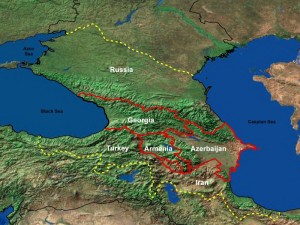Azerbaijan
Caucasus Mountains
The Caucasus Mountains lie between the Black and Caspian Seas and contain the highest mountain in Europe, Mount Elbrus (Russia). In ancient times it was the location of several kingdoms of whom two were known as Albania and Iberia.(d)>Today, they contain a small part of the Russia Federation along with the former Soviet republics of Armenia, Azerbaijan and Georgia.<
mountain in Europe, Mount Elbrus (Russia). In ancient times it was the location of several kingdoms of whom two were known as Albania and Iberia.(d)>Today, they contain a small part of the Russia Federation along with the former Soviet republics of Armenia, Azerbaijan and Georgia.<
>Delisle de Sales was probably the first to suggest the Caucasus as the home of the original Atlantis, with refugees from there establishing Plato’s Atlantis in the Central Mediterranean. However, the greatest proponent of the Caucasus location for Atlantis was R.A. Fessenden who wrote, The Deluged Civilisation of the Caucasus Isthmus, an extensive multi-volume work [1012] on the subject published early in the 20th century.<
>Regarding the Pillars of Herakles being in the Caucasus Fessenden noted “The fact that Nebuchadnezzar, after reaching them in his northern expedition, next went to the north shore of the Black Sea and to Thrace; and that Hercules, coming back from the pillars with the cattle of Geryon, traversed the north shore of the Black Sea (see Megasthenes, quoted by Strabo and Herodotus, 4.8), puzzled the ancient geographers because they thought that the Pillars were at the straits of Gibraltar. And because they had overlooked the fact that the Phoenicians of Sidon had known that the Pillars had been lost and that the Phoenicians had sent out four expeditions to look for them but had reached no conclusion from these expeditions except that the straits of Gibraltar were not the true Pillars of Hercules.” See Strabo, 2.5 (m)<
More recently, Ronnie Gallagher, an admirer of Fessenden, has studied the Caucasus region, in particular,  the hydrology of the Caspian Sea(a), where he identified strandlines up to 225 metres above sea level (ASL), which he considers to be evidence of a vast inland Eurasian sea at the end of the last Ice Age. In Azerbaijan, he also found cart ruts similar to those on Malta as well as stone circles on the Absheron Peninsula(b). Professor E. N. Badyukova has offered some critical comments regarding Gallagher’s claims(k).
the hydrology of the Caspian Sea(a), where he identified strandlines up to 225 metres above sea level (ASL), which he considers to be evidence of a vast inland Eurasian sea at the end of the last Ice Age. In Azerbaijan, he also found cart ruts similar to those on Malta as well as stone circles on the Absheron Peninsula(b). Professor E. N. Badyukova has offered some critical comments regarding Gallagher’s claims(k).
Flinders Petrie also referenced Fessenden in his (1926) paper The Origins of the Book of the Dead(f), in which he concluded “that the cultural connections of the earliest Egyptians, as well as the physical descriptions in their mythology, point to the Caucasus region. When, further, we find there the names of the principal places of the mythology in their relative positions, it gives strong grounds for regarding that region as the homeland of the earliest civilisation of the Egyptians.”
A few years later, an article by Margaret A. Murray in Antiquity (Volume 15 – Issue 60 – Dec. 1941) noted that Petrie’s “opinion was based entirely on literary and philological evidence” resulting in archaeologists being slow to accept it. To partially counter this Murray offered two pieces of evidence in support of Petrie’s proposed Egyptian-Caucasus connection.(i)
However, I must point out that in 1874 Hyde Clarke delivered a paper to the Royal Anthropological Institute in which he claimed that the Colchians in the Caucasus had been an Egyptian colony(h). Clarke also employed language similarities>and Herodotus’ Histories (Bk2.102-106)< to support his contention. So we can reasonably ask, who was right or were both Clarke and Flinders Petrie wrong?
A forum on Graham Hancock’s website offered some more discussion about an Egyptian link with the Caucasus(j).
Jean-Michel Hermans has claimed that the megalith builders of Brittany originally came from the Caucasus, and arrived there after a stop in what is now Bulgaria around 5000 BC(l),>and while there, they discovered mathematical relationships such as ‘pi’ and the ‘golden ratio’ !<
The Amazons of Greek mythology are thought by some to have originated in the Caucasus and as late as 1671, Sir John Chardin reported that a tribe of Amazons existed in Georgia. Interestingly, a 19th-century photo shows two armed ladies from Armenia captioned as ‘Amazons of Armenia 1895’.
An added mystery was offered by Alexander Braghine, who recounted that “I was present when a former Russian officer of Georgian origin found himself able to talk with the natives of Vizcaya immediately upon his arrival in Northern Spain: he spoke Georgian, but the Basques understood this language.” [156.187]
Currently, Bruce Fenton has claimed the Caucasus as the home of giants. However, Jason Colavito has demonstrated the unreliability of his claims(c).
In the Krasnodar region of southern Russia hundreds (actually 3,000 and counting) of dolmens are to be found on both sides of the Caucasus. Interestingly, they show a distinctive form of megalithic architecture(g).
I feel that the Caucasus will have a lot more to tell us.
(a) Wayback Machine (archive.org)
(b) https://www.azer.com/aiweb/categories/magazine/ai103_folder/103_articles/103_cart_ruts.html
(d) https://en.wikipedia.org/wiki/Caucasian_Albania
(f) Archive 6947 | (atlantipedia.ie)
(g) The mysterious dolmens and megaliths of the Caucasus – The Tapestry of Time (larazzodeltempo.it)
(h) https://www.jstor.org/stable/pdf/2841305.pdf
(i) Antiquity, Vol. 15, Issue 60, Dec. 1941 p.384-386
(j) New article: Observations on Late Pleistocene Flooding of the… – Graham Hancock Official Website
(k) Archive 7221 | (atlantipedia.ie)
(l) Amazon.fr
Gallagher, Ronnie
Ronnie Gallagher is a retired environmental manager and an amateur archaeologist with a great interest in the Caucasus region, where  he has carried out extensive research. He has written an interesting paper on the effects of the post-glacial flooding of the Caspian Sea and its former physical connection with the Black Sea as well as with the Arctic Ocean(a).
he has carried out extensive research. He has written an interesting paper on the effects of the post-glacial flooding of the Caspian Sea and its former physical connection with the Black Sea as well as with the Arctic Ocean(a).
Gallagher has also drawn attention to cart ruts in Azerbaijan(b) similar to, but not as numerous as, those on Malta. He is also an admirer of the work of Reginald Fessenden who placed Atlantis in the Caucasus(c) and proposed that migrants from that region were responsible for kick-starting what we know as the Egyptian civilisation. The renowned Flinders Petrie and Margaret Murray were sympathetic to this view, as is Gallagher(d).
However, Gallagher goes further and suggests that people from the Caucasus were also responsible for the development of the great cultures of Sumeria and the Indus Valley!
>Gallagher expanded on his view that migrants from the Caucasus had settled in Egypt, suggesting that they brought with them memories of their homeland and one of its best-known landmarks – Mount Barmak in modern Azerbaijan and used its outline to inspire the Great Sphinx at Giza(g)!!! In another paper, he expands on anthropomorphic images in Azerbaijan(l).<
His own conclusion regarding the location of Atlantis in the Caucasus region was that it was inundated as a consequence of the creation of a vast ‘flooded Eurasia’ that resulted from the collapse of glacial ice-dams(d)(h)(m), comparable with the Lake Missoula Floods in America.
Gallagher’s paper should be read in conjunction with a 2004 paper(e) from a team of Russian and US scientists that relates to a ‘Giant Siberian Lake’.
>Related to this is a recent study that has shown that 12 million years ago the same vast region was home to the Earth’s largest-ever lake, which the authors have called Paratethys(i). In fact, it is claimed that its history begins even further back at 34 million years ago and at its greatest extent stretched from Germany to China!(j)<
Gallagher’s studies in Azerbaijan continue, where he has identified an extensive number of strandlines in the region resulting from ancient catastrophic flooding.
>His presentation to the Second International Conference on the Aral Sea Problems in 2019 in St. Petersburg is available online in a lengthy and extensively illustrated pdf file(k).<
He has now published a number of extended abstracts of recent papers on the academia.edu website(g). He concluded one(f) with the following: “However, the thorny problem of what might have caused the Gilazi strandlines and the inferred worldwide flood can only be speculated on and will be controversial.
Perhaps open-minded discussion on the theories, such as the reality of the diverted Russian Rivers, an enlarged Ponto Caspian and the ingress of marine waters into the Eurasian continental interior might begin to reveal a different pre-history and provide support for a world-wide flood.”
Also See: Lake Agassiz, Deglaciation and Melt Water Pulses.
(b) https://www.azer.com/aiweb/categories/magazine/ai103_folder/103_articles/103_cart_ruts.html
(c) https://www.radiocom.net/Deluge/Deluge1-6.htm
(d) https://www.grahamhancock.com/forum/GallagherR1.php
(e) See Archive 2372)
(j) https://www.researchgate.net/project/The-evolution-of-Paratethys-the-lost-sea-of-Central-Eurasia
(l) Anthropomorphic Images in Azerbaijan’s Landscape – Graham Hancock Official Website

